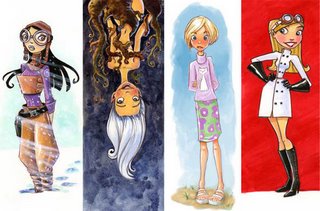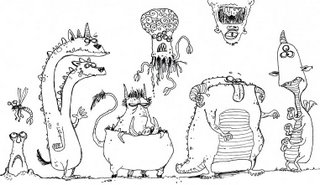GUY FRANCIS INTERVIEW
Illustrator and Animator.
Thursday, May 11, 2006
BROUGHT TO YOU BY THE CHARACTER DESIGN BLOGSPOT
IF YOU WOULD LIKE TO SEE MORE CHARACTER DESIGNERS GO TO THE HOME PAGE BY CLICKING HERE
THE INTERVIEW

Tell me a little bit about yourself, about your life? Where did you go to school, and what classes did you study? What helped prepare you to become the artist that you are today?
I was born and raised in Provo, Utah. I am the sixth of seven children. I was always considered the odd one in my family because of my interest in art. I agreed. I’ve always been interested in art and building and creating things, even at an early age. In elementary school friends asked me to draw pictures for them for a nickel, which began my interest in art as a career. I knew I wanted to be an artist, but I didn’t want to just do the kind of art that hangs on walls. I didn’t know what an illustrator was, but I knew I wanted to do the kind of art in books and magazines. Finally some professors pointed me in the right direction, and I found myself in the design department at Brigham Young University studying illustration.
How do you go about designing a character, and what goes through your mind, from start to end?
Most of the work I do is in the children’s market, so I try to think on a child’s level. My wife says I spend a lot of time there.
My clients usually give me an idea of what they want. They give me a concept, a description, or a manuscript. That starts the juices flowing. I think of the overall story, the environment, the mood and the setting. It all seems to play a part in the early design stages. I also try to think of the attitude and personality of the character I’m working on. I try to put myself in his mind and think like he does. This helps me think of the character’s shape, size, postures, and emotions. Sometimes my sketching is very deliberate—I know what I want when I start—and sometimes I just start drawing and the character emerges from the pencil spontaneously. I have a hard time doing anything very serious. Most of my stuff is lighthearted kind of goofy. I like it when my character interacts with the viewer.
What do you think really helps you out in designing a character?
Drawing all the time. That’s first and foremost. But I’m also very influenced by other artists’ work. I love seeing the way other artists sketch. I’ve got a huge file of artists’ work that really inspires. I have it set as my screen saver so that pictures shuffle through and they often spark an idea and get me going.
From your own experience and maybe from some people that you know, what should we put in our portfolio and what should we not?
Early on in my career I would have said 12 strong pieces, tops. But now as I’ve seen the market change, I feel a better approach is to build a portfolio targeted to the specific client or field. For example, my portfolio pieces that are shown to clients in the editorial market are different than those shown to clients in the children’s book market. My rep will actually build a portfolio of pieces they think that particular client will be most interested in. I also think an online gallery is extremely helpful because the client might be grabbed by my portfolio, and then they can see additional work instantly to help in their decision.
What are some of the things that you have worked on?
I spent the first 10 years of my illustration career doing illustration and animation for educational software, freelancing on the side. Now I spend most of my time doing picture books, book covers and interiors for early chapter books, card games, and the occasional editorial piece.
These are my published works and clients:
Some of my clients include:
Fundex
Gamewright
Golden Books
Hyperion Books for Children
Mondo Publishing
Penguin/Dutton
Random House
Rose and Wesley
Scholastic
Scott Foresman
Simon and Schuster
Wall Street Journal
Weekly Reader
Is there a character design you have done that you are most proud of?
I don’t necessarily have a favorite, but I really enjoy designing animals and creatures. Of the characters I’ve done for picture books, I really like Mrs. McBloom the old teacher with a messy classroom and Stanley the pig who wanted to make it on Broadway. I also had fun designing an African Santa, complete with dreadlocks.
What are you working on now? (If you can tell us)
I’m doing covers for a series of early chapter books called Ghosthunters by Cornelia Funke, a series called Ghostville Elementary by Marcia Thornton Jones, Debbie Dadey, a picture book called At the End of the Day by Rita Grey, and about a million other things. On the side I’m also working on a few ideas for books I’m writing and illustrating myself.
Where is the place you would like to work if you had a choice?
My basement. I like working from my home studio. It’s close to my wife and kids, and the commute is great.
Who do you think are the top character designers out there?
Peter DeSeve is one of my favorites. I’m also finding a lot of other great character designers from this blog and others. There’s a lot of really great work out there.
How do you go about coloring the character, what type of tools or media do you use?
I primarily draw with a brown or black col-erase pencil. They are wonderful. I normally paint with acrylics on Arches 140 lb hot press watercolor paper. I do play around on the computer (Photoshop with a Wacom) once in a while, too.
What part of designing a character is most fun and easy, and what is most hard?
The best part of designing a character is when you capture the “look” right off, and you know it. The worst part is when you know what you want, but it takes forever to figure out how to draw it.
What are some of your favorite character designs and least favorite, which you have seen?
It’s hard to say because there is so much great stuff out there, but I really like stuff that is stylized, but that has believable anatomy. I really like seeing solid drawing skills.
What is your most favorite subject to draw? And why?
I have the most fun drawing faces, creatures, animals, machinery and gizmos. I like drawing stuff that interests me or makes me laugh. I don’t like drawing unicorns, although I’ve never drawn one, so it’s hard to say.
What inspired you to become an Artist?
Mostly encouragement from friends and family, plus some great artwork in children’s books and Saturday morning cartoons growing up.
What are some of the neat things you have learned from other artists that you have worked with or seen?
I learn new stuff from artists every day. Whenever I see artwork that I like, I try to incorporate the things I like into my own work, such as color, lighting, composition, etc.
What wisdom could you give us, about being an Artist? Do you have any tips you could give?
The best advice I’ve ever given or received is to draw all the time. Put some mileage on your pencil and you’re bound to get better. Don’t try to imitate someone else or follow the trends. Do what you love and do it well. Most likely there will be others who enjoy your work too.
If people would like to contact you, how would you like to be contacted?
Most work I do is through my rep.
www.shannonassociates.com
I can also be contacted through my website or email.
guy@guyfrancis.com
www.guyfrancis.com
Finally, do you have any of your art work for sale (sketchbook, prints, or anything) for people that like your work can know where and when to buy it?
Most of my books are available in bookstores or online. You can find links for most things on my website.
Subscribe to:
Comments (Atom)


















